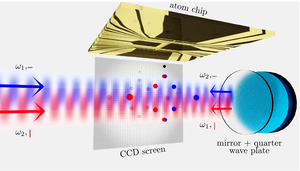Atom optical tools for enhanced matterwave interferometry
Recently, atom interferometers were suggested for gravitational-wave detection. Here, they can access an interesting frequency domain, which is not reached by instruments based on optical interferometry neither on ground nor in space. One key aspect to achieve the required sensitivities is a large momentum separation between the wave packets in the interferometer.
We use an optical lattice (our so-called twin lattice) to create a symmetric beam splitter which is based on Bragg diffraction and Bloch oscillations. With this, we realize an interferometer with a momentum splitting of 408 photon recoils, the largest reported so far.
Compared to other experiments, our setup offers better scalability due to low atom and contrast loss. Furthermore, the symmetry suppresses systematic errors. Apart from gravitational-wave detection, our scheme can be employed in compact inertial sensors such as gradiometers, gyroscopes, or tiltmeters.

Related publications
H. Ahlers et al.: Double Bragg Interferometry, Phys. Rev. Lett. 116, 173601 (2016)
M. Gebbe et al.: arXiv:1907.08416


 "
"